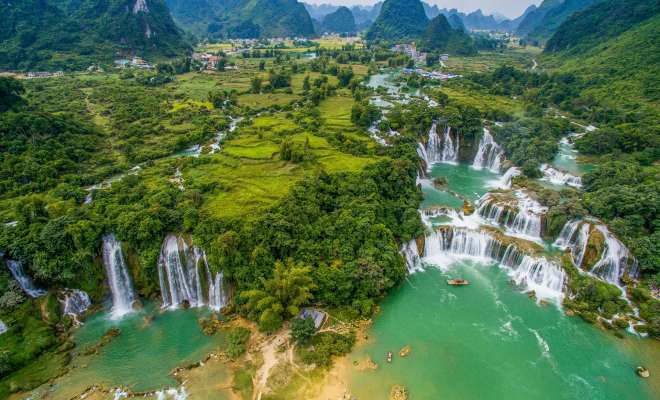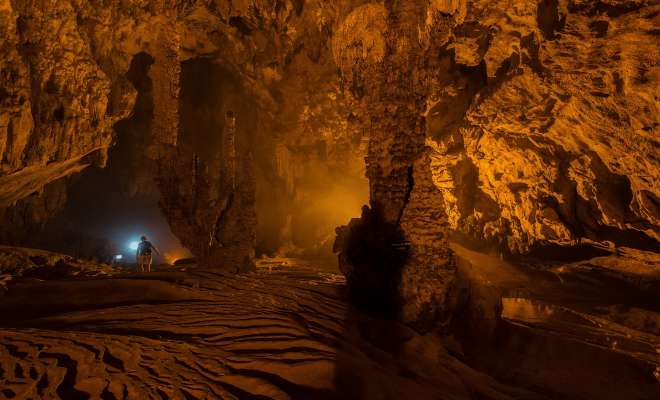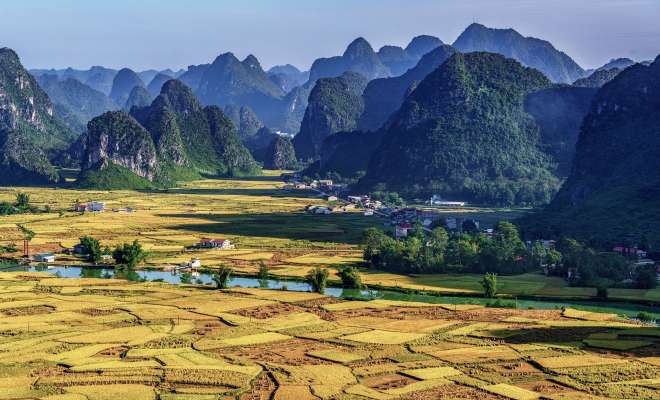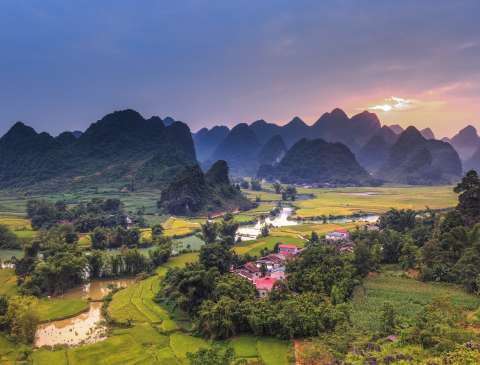Cao Bang is a remote, mountainous and amazingly beautiful province on the north-eastern Vietnam-China border, about 6 hours drive north of Hanoi.
Few western travelers have heard of it, which is a pity because it has so much to offer — especially the recently announced Non Nuoc Cao Bang Geopark. Recognized by the UN in 2018, the name translates roughly as “the beauty of the rivers and mountains”. It is Vietnam’s second Geopark (the other is the Dong Van Karst Plateau to the north), and it’s true to its name: the region has a mix of stunning karst mountains, beautiful lakes & rivers, majestic waterfalls, caves and ethnic villages found nowhere else.
The region is probably most known for the magnificent Ban Zioc falls, which we think are the best in Vietnam.
The multi-tiered falls are broad rather than high. In good flow, the Son Quay river thunders over the cliffs, plummeting into various pools set against a backdrop of limestone pinnacles surrounded by rice fields and bamboo groves. Truly spectacular.

One of our customers on seeing the falls immediately extended his tour by a day and spent the time observing, reading and exploring. Seemed completely understandable to us!
The Son Quay forms a natural border between Vietnam and China. Small Vietnamese and Chinese boats row visitors across the largest pool to the base of the falls, an exhilarating mist-blown experience. For the adventurous, there are also trails that allow you to climb between the different falls to gain spectacular viewpoints.
Nearby is splendid 300-million year old Nguom Ngao (‘Tiger’) cave, one of the more impressive cave systems in North Vietnam. A meandering section of about 1km has been opened and lit for visitors, with awe-inspiring caverns and great flowstone, stalactite and other cave formations.

The roads east of Cao Bang to Ban Gioc falls, and also those radiating northwest, west & southeast of the city, fan out into the different arms of the Non Nuoc Cao Bang Geopark.
Home to five major river systems and 47 lakes, Cao Bang’s attractions revolves primarily around water, but its extraordinary diversity of spectacular landscapes, historical monuments, and ethnic villages & people offer some of the best car and motorbike touring in North Vietnam.

Although the falls are one of Vietnam’s most impressive natural sights, Cao Bang province, itself, is bountiful in other remarkable geo-cultural sites, as well as stunning karst landscapes and rich biodiversity. Non Nuoc Cao Bang (translates to “the beauty of the mountains, rivers, and waterfall in Cao Bang”) has somewhat recently been honourably awarded the UNESCO title of Non Nuoc Cao Bang Geopark, following the recognition of the Dong Van Karst Plateau Geopark in 2010.
The Cao Bang area houses two outstanding caves that are well worthy of exploration: Pac Bo and Nguom Ngao.
Pac Bo cave, whose concealed entrance is accessed by walking through the dense jungle foliage, along the tranquil waters of Lenin creek, is historically significant as the temporary sanctuary of the legendary leader Ho Chi Minh when he took refuge there in 1941 after crossing back over into Vietnam following his 30-year exile.
The 300-million-year-old Nguom Ngao cave is beautifully adorned with an impressive collection of some of the most unique formations of stalactites and stalagmites in SE Asia, as well as thousands of small grottos. Undebatably a valuable gift of nature.
Trúc Lâm Phật Tích Pagoda, reputedly the first pagoda to be constructed in Vietnam’s northern frontier, is of traditional Vietnamese-style architecture, and, nestled into the hillside, it offers a breathtaking panoramic view of the area and the waterfalls.
Cao Bang province is rich in the cultural heritage of more than nine ethnic tribes, of which the Tày, Nùng, Dao, and H’mong are the most well-known. Each minority practices its own traditions and customs, and creates its own unique crafts. Staying in local home stays is an excellent way to get a first-hand glimpse into the lives of these proud, resourceful people.
Last but not least, the city of Cao Bang, on the banks of the Song Bang river, previously viewed only as a rest area on the way to Ban Gioc or the Chinese border crossing, has, in recent years, blossomed into a bustling center of development. Its small but somewhat contemporary selection of hotels, cafes, eateries, and shops should prove sufficient to suit all needs and tastes.
What are you waiting for? Non Nuoc Cao Bang Geopark awaits!

